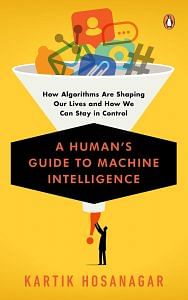All of us realize how much of our lives are shaped by the decisions we make online, whether through searches on Google, connecting with friends on Facebook, or shopping on Amazon. Many of us are aware that the companies running these sites are guiding our choices, often by customizing our experience on their websites and apps.
Personalization algorithms help us choose the optimal products to buy on Amazon, the best movies to watch on Netflix, the ideal person to date through Tinder and Match.com, the most useful contacts on LinkedIn, and the most compelling posts and articles to read on Facebook. But in our imagining, we generally nod politely at these recommendations and make our own choices. After all, we are in charge here.
And yet consider these facts: 80 percent of viewing hours streamed on Netflix originate from automated recommendations. By some estimates nearly 35 percent of sales at Amazon originate from automated recommendations. And the vast majority of matches on dating apps such as Tinder and OkCupid are initiated by algorithms. Given these numbers, many of us clearly do not have quite the freedom of choice that we believe we do.
One reason is that products are often designed in ways that make us act impulsively and against our better judgment. For example, suppose you have a big meeting at work tomorrow. Ideally, you want to spend some time preparing for it in the evening and then get a good night’s rest. But before you can do either, a notification pops up on your phone indicating that a friend tagged you on Facebook. This will take a minute, you tell yourself as you click on it. But after logging in you discover a long feed of posts by friends. A few clicks later you find yourself watching a YouTube video that one of them shared. As soon as the video ends, YouTube suggests other related and interesting videos. Before you know it, it’s 1:00 a.m., and it’s clear that you will need an all-nighter to get ready for the following morning’s meeting. This has happened to most of us.
The reason this behavior is so common, as some product designers have noted, is that popular design approaches—such as the use of notifications and gamification to increase user engagement—exploit and amplify human vulnerabilities, such as our need for social approval, or our inability to resist immediate gratification even when we recognize that it comes with long- term costs.
While we might feel as if we are making our own choices, we’re often nudged or even tricked into making them.
Another reason that we aren’t truly in control of our choices is that when we search for a hotel on Expedia, browse online dating profiles, or shop for a book, we’re seeing only a small fraction of all the potentially relevant information available. Although we experience a clear sense of free will by making the final decision regarding what we see, read, or buy, the fact is that 99 percent of all possible alternatives were excluded.
You probably don’t mind saving all the time you might have wasted in sifting through inferior options to arrive at a final choice. But algorithms do not simply help us find products or information more quickly that we might have found eventually without their assistance. In truth, they exert a significant influence on precisely what and how much we consume.
Consider the role of search algorithms. Given millions of possible search results, thousands of which are likely to be highly relevant to a particular query, Google’s algorithms determine which ones are featured at the very top of the results page. This ranking exerts a powerful influence on our responses. About 33 percent of clicks go to the number- one result in Google searches; fewer than 10 percent go to links outside of the top ten results.
Automated recommendations are also a major driver of choice online. More than any individual or organization— including Oprah, the National Book Awards, or The New York Times— Amazon’s recommendation algorithms have the biggest influence on which books people are reading. Automated recommendations drive purchase decisions across a wide variety of product categories, from kitchenware and perfumes to electronics and artwork.
Beyond retailers such as Amazon and Walmart.com, online media companies such as Netflix, Spotify, Apple’s iTunes, and Google’s YouTube all employ algorithmic recommendations to gently nudge us in specific directions.
The impact of algorithms is also experienced on social media websites, where we are likely to believe that our friends are the chief drivers of the content we see. In reality, algorithms play an equally important role. Every time a user opens Facebook’s app or website, there are on average about 1,500 potential stories or posts that Facebook can show. Its algorithms determine which ones you should read first, which can be read later, and even which you don’t need to read at all.
The algorithms consider a number of factors to determine the posts they show us— how often we interact with the friend who posted; the number of likes, comments, and shares that the post received in aggregate and from our friends; how recently the post appeared; whether any users tried to hide it; and so on. Instagram and Twitter have also recently adopted algorithmic feeds. Given how social networks have become the gateway for online news and media discovery for so many of us, news- feed algorithms are crucial to determining the reportage we read and the opinions we form about the world around us.
Perhaps inevitably, algorithms are not just selecting the media we see on social networks but are also silently determining the network itself— that is, whom we allow into our personal and professional lives.
LinkedIn’s algorithms will magically remind you of the people you met last week or emailed yesterday so they can be added to your professional network. Interested in reconnecting with childhood friends? Facebook’s algorithms will recommend whom to add as friends on Facebook. And why stop at friends? Algorithms built by companies such as Tinder, Match.com, and eHarmony will even determine whom you date or marry. Algorithms are the primary drivers of matches on online dating apps and websites, which, by some estimates, are used by as much as 40 percent of the singles population in the United States.
 This excerpt from A Human’s Guide to Machine Intelligence by Wharton professor and tech entrepreneur Kartik Hosanagar has been published with permission from Penguin Random House India.
This excerpt from A Human’s Guide to Machine Intelligence by Wharton professor and tech entrepreneur Kartik Hosanagar has been published with permission from Penguin Random House India.






